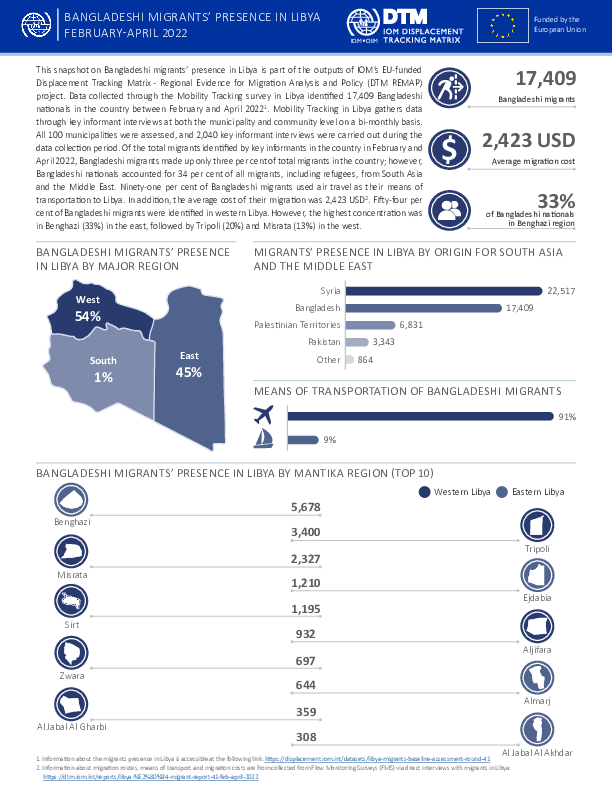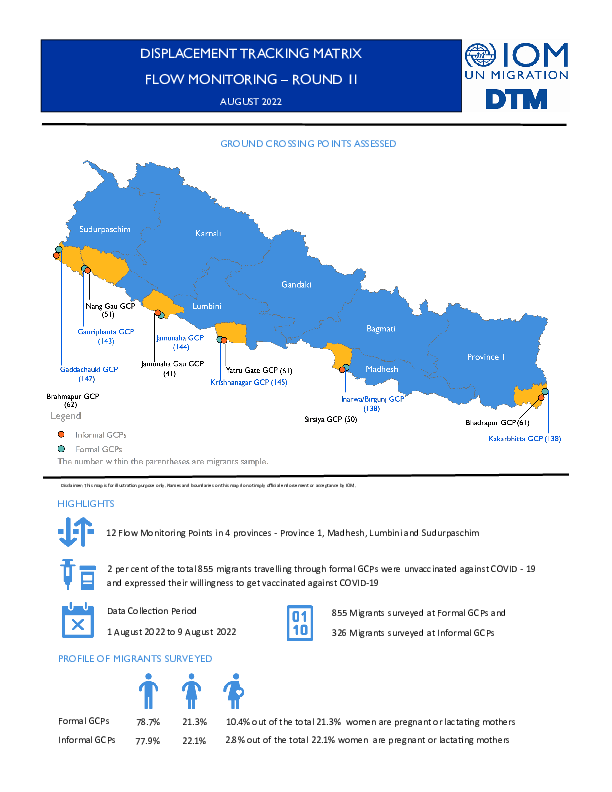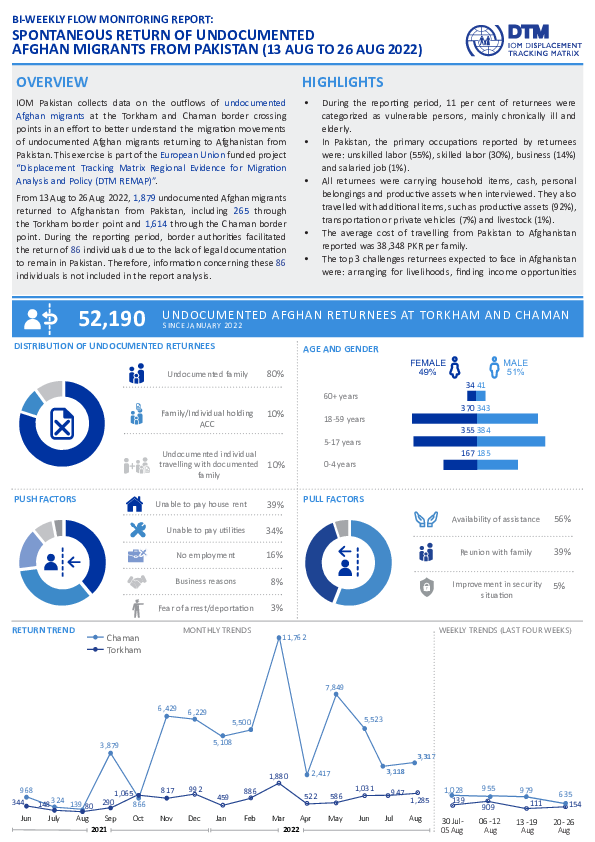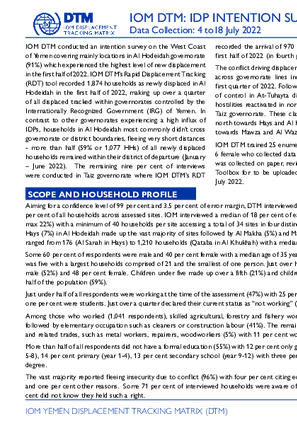-
Countries
-
Data and Analysis
-
Special Focus
-
Crisis Responses

Contact
DTMAfghanistan@iom.int
Language
English
Location
Afghanistan
Period Covered
Jan 01 2021
Dec 31 2021
Activity
- Flow Monitoring
- Migrants presence
This snapshot summarizes available data on Afghan, Bangladeshi, Iranian, Iraqi and Pakistani nationals’ arrivals in the European Union in 2021. Official data on first arrivals to the European Union by land and by sea is made available by national authorities in Bulgaria, Cyprus, Greece, Italy, Malta and Spain and then gathered by IOM DTM Europe. For 2021, disaggregated data by nationality is available for land arrivals in Bulgaria, sea arrivals in Greece, Italy and Malta, and for sea and land arrivals in Spain.
The snapshot is part of the outputs of the EU-funded Displacement Tracking Matrix (DTM) project “Regional Evidence for Migration Analysis and Policy” (REMAP). The objective of DTM REMAP is to strengthen the evidence-based formulation and implementation of humanitarian and development policy and programming on migration and forced displacement in Afghanistan, Bangladesh, the Islamic Republic of Iran, Iraq and Pakistan.
As part of the third phase of the Libyan national COVID-19 vaccination campaign led by the Libyan National Centre for Disease Control (NCDC), IOM and NCDC conducted awareness raising sessions on COVID-19 vaccines with a total of 1,143 adult migrants (1,134 males and 9 females) in urban settings in two municipalities. Additionally, 331 (330 migrants and 1 Libyan have received COVID-19 vaccination in urban settings in five municipalities during the reporting period (28 Aug - 3 Sep 2022).

Contact
DTM Afghanistan, DTMAfghanistan@iom.int
Language
English
Location
Afghanistan
Period Covered
Jun 18 2022
Jul 16 2022
Activity
- Survey
To better understand the demographic profiles, living conditions and reintegration processes of Afghan returnees, IOM, under the EU-funded project “Displacement Tracking Matrix Regional Evidence for Migration Analysis and Policy (DTM REMAP)”, developed the Returnee Longitudinal Survey (RLS).
This report provides a snapshot of the sixth round of RLS data collection which took place from 18 June to 16 July 2022 among Afghan migrants who had returned from Türkiye or the EU between January 2018 and July 2021. A total of 587 returnees (509 from Türkiye and 78 from the EU) were interviewed over the phone across 98 districts in 17 provinces.
Contact
DTM Libya, DTMLibya@iom.int
Language
English
Location
Libya
Snapshot Date
Jul 31 2022
Activity
- Mobility Tracking
- Site Assessment
Detention Centre Profiling is a component of IOM Libya’s Displacement Matrix programme. It is a data oriented tool that routinely provides specific sex and age demographic data and key sectoral information on individuals held in Libya’s detention centres on the date of assessment.
Contact
DTM Libya, DTMLibya@iom.int
Language
English
Location
Libya
Snapshot Date
Aug 28 2022
Activity
- Mobility Tracking
- Site Assessment
Detention Centre Profiling is a component of IOM Libya’s Displacement Matrix programme. It is a data oriented tool that routinely provides specific sex and age demographic data and key sectoral information on individuals held in Libya’s detention centres on the date of assessment.

Contact
REMAPBD@iom.int
Language
English
Location
Bangladesh
Period Covered
Feb 01 2022
Apr 30 2022
Activity
- Migrants presence
This snapshot on Bangladeshi migrants’ presence in Libya is part of the outputs of IOM’s EU-funded Displacement Tracking Matrix - Regional Evidence for Migration Analysis and Policy (DTM REMAP) project. Data collected through the Mobility Tracking survey in Libya identified 17,409 Bangladeshi nationals in the country between February and April 20221 . Mobility Tracking in Libya gathers data through key informant interviews at both the municipality and community level on a bi-monthly basis. All 100 municipalities were assessed, and 2,040 key informant interviews were carried out during the data collection period. Of the total migrants identified by key informants in the country in February and April 2022, Bangladeshi migrants made up only three per cent of total migrants in the country; however, Bangladeshi nationals accounted for 34 per cent of all migrants, including refugees, from South Asia and the Middle East. Ninety-one per cent of Bangladeshi migrants used air travel as their means of transportation to Libya. In addition, the average cost of their migration was 2,423 USD2. Fifty-four per cent of Bangladeshi migrants were identified in western Libya. However, the highest concentration was in Benghazi (33%) in the east, followed by Tripoli (20%) and Misrata (13%) in the west.

Contact
iomnepal@iom.int
Language
English
Location
Nepal
Period Covered
Aug 01 2022
Aug 09 2022
Activity
- Survey
- Flow Monitoring Survey
IOM Nepal collected data at 12 ground crossing points (GCPs) six formal and six informal, in an effort to better understand the migration movements between India and Nepal. The exercise intended to collate feedback from the migrants for improving COVID-19 related response and deliver multisectoral services, ultimately contributing to strengthen the GCPs’ capacities, providing safe and regular crossing for migrants. This exercise was conducted as a part of European Union Directorate General for European Civil Protection and Humanitarian Aid Operations funded “Effective Case Management by Strengthening Isolation Centres and Ground Crossing Points (GCPs) Management for Rapid Response and Preparedness Against COVID-19” project.
In total, 1181 individuals (855 at formal GCPs and 326 at informal GCPs) were interviewed for the flow monitoring exercise in Province 1, Madhesh, Lumbini and Sudurpaschim Provinces. The report presents data collected on flows, demographics profile of migrants, services available to the migrants at the formal GCPs and suggestions for improvement of services. The survey at the informal GCPs was conducted to primarily assess the intensions of migrants for using informal GCPs. Since multisectoral services are only available at the formal GCPs, the survey does not include questions on services at informal GCPs.

Contact
DTM Pakistan, iomisbdtmremapteam@iom.int
Language
English
Location
Pakistan
Period Covered
Aug 13 2022
Aug 16 2022
Activity
- Flow Monitoring
IOM Pakistan collects data on the outflows of undocumented Afghan migrants at the Torkham and Chaman border crossing points in an effort to better understand the migration movements of undocumented Afghan migrants returning to Afghanistan from Pakistan. This exercise is part of the European Union funded project “Displacement Tracking Matrix Regional Evidence for Migration Analysis and Policy (DTM REMAP)”.
From 13 Aug to 26 Aug 2022, 1,879 undocumented Afghan migrants returned to Afghanistan from Pakistan, including 265 through the Torkham border point and 1,614 through the Chaman border point. During the reporting period, border authorities facilitated the return of 86 individuals due to the lack of legal documentation to remain in Pakistan. Therefore, information concerning these 86 individuals is not included in the report analysis.

Contact
DTM Yemen, DTMYemen@iom.int
Language
English
Location
Yemen
Period Covered
Jul 04 2022
Jul 18 2022
Activity
- Site Assessment
IOM DTM conducted an intention survey on the West Coast of Yemen covering mainly locations in Al Hodeidah governorate (91%) which experienced the highest level of new displacement in the first half of 2022. IOM DTM’s Rapid Displacement Tracking (RDT) tool recorded 1,874 households as newly displaced in Al Hodeidah in the first half of 2022, making up over a quarter of all displaced tracked within governorates controlled by the Internationally Recognized Government (IRG) of Yemen. In contrast to other governorates experiencing a high influx of IDPs, households in Al Hodeidah most commonly didn’t cross governorate or district boundaries, fleeing very short distances - more than half (59% or 1,077 HHs) of all newly displaced households remained within their district of departure ( January – June 2022).

Contact
DTM Europe, DTMMediterranean@iom.int
Language
English
Location
Slovakia
Period Covered
Mar 09 2022
Aug 11 2022
Activity
- Survey
- Return Intention
Since 24 February 2022, an increasing number of refugees and third-country nationals (TCNs) entering Slovakia has been registered as a result of the war in Ukraine. As of 30 August 2022, Slovak authorities have reported 750,101 arrivals from Ukraine out of whom 692,924 were refugees from Ukraine and 15,547 other TCNs.
This report is based on a displacement patterns, needs and intentions survey launched by IOM Displacement Tracking Matrix (DTM). All surveys were conducted face-to-face by IOM Slovakia trained enumerators with refugees from Ukraine and other TCNs fleeing Ukraine. This report presents a short analysis based on 1,298 surveys collected between 9 March and 11 August 2022.
Between 9 March and 11 August 2022, IOM conducted 1,298 displacement patterns, needs and intentions interviews with refugees from Ukraine and other TCNs at 2 Border Crossing Points (BSPs) at Vyšné Německé, Ubl'a, 2 Registration centres at Michalovce, Humenné and Červená Hviezda Hotspot.

